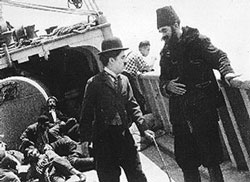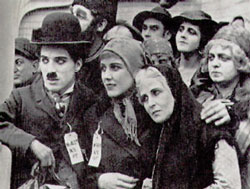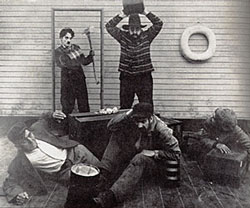Film - The Immigrant
Charlie Chaplin (1889-1977)
- NEVER BECAME AN AMERICAN CITIZEN (Lived in the USA between 1913 and 1952)
- Born April 16, 1889, in London; Died December 25, 1977, in Switzerland
- Made 87 Films during a film career that lasted more than 50 years.
- Wrote an autobiography, My Autobiography (Simon and Schuster, ©1964)
- Born to music hall entertainers in England - Parents separated when he was only 1 year old. His mother, after numerous nervous breakdowns, and absentee father left Charlie and his half-brother Sydney Chaplin to spend time in and out of charity homes, on the street, and in an orphanage.
- Toured England in the musical "The Eight Lancaster Lads" at 8 years of age and later appeared in various stage shows in London
- From 17 to 24 he toured with Fred Karno's vaudeville troop and toured New York in 1910 for the first time.
- Film Companies Before United Artists -
- 1913, Chaplin signed with Keystone Studios in New York City - would make 35 movies with Keystone in 1914. Paid $175 a week.
- 1915 made 14 films for Essanay Studios. Paid $1,250 a week and maintained complete creative control over his subjects.
- 1916-1917 12 two-reel films for Mutual Studios--- Including The Immigrant. $10,000 a week in addition to bonuses, creative autonomy (highest paid actor in the world). Allowed a month to produce each of his 2-reel films (normally they were produced in 2 days.)
- 1918 joins First National. Given a million-dollar contract that demanded only 8 two-reel films a year.
- 1919 founds his own film studio, United Artists, with Douglas Fairbanks, Mary Pickford, and D.W. Griffith.
- Awarded an honorary Academy Award at the first Academy Awards ceremony in 1929 for his acting, writing, directing, and producing The Circus.
- 1931's City Lights, Chaplin set the film to music and added sound effects. He wrote the musical scores for all his films and even added musical tracks to his a number of his old silent movies.
- Produced first full-length "talkie" The Great Director in 1940 after years of delaying the addition of full sound to films.
- Married four times and had 13 children by three wives (8 by Oona Chaplin, whom he married in 1943 and stayed with her until his death). All of his wives were in their late teens at the time of their marriage to Chaplin.
- In the late 1930s, Chaplin began to tackle controversial political issues, especially in his 1940 film, The Great Dictator, and 1947 movie, Monsieur Verdoux. At the beginning of the Cold War in the late 1940s and early 1950s, J. Edgar Hoover's FBI put together an almost 2,000 page file on Chaplin's activities. Called to testify before the House Un-American Activities Committee - he denied the committee's charges that he was a Communist. When he went to London in 1952 with his fourth wife, the U.S. notified him that he would not be able to gain reentry. U.S. film audiences turned against Chaplin films and his future efforts flopped.
- Bitter over the treatment he received in 1952, Chaplin only returned to the U.S. in 1972 when he received a special Oscar for outstanding career achievement.
- Knighted
by Queen Elizabeth II in 1975.
For More information on Charlie Chaplin or his films see http://www.chaplinsociety.com
 The
Tramp Character
The
Tramp Character
Chaplin's trademark character first appeared in the 1914 Kid Auto Races at Venice with him outfitted in a derby hat, droopy pants, and a cane. Chaplin refined the Tramp character during the rest of his 1914 tenure with Keystone and continued to perfect it during the Essanay period, even filming a movie entitled, The Tramp. Chaplin always appeared as the Tramp in his movies except the first one. The Tramp character was "Everyman" - a funny but downtrodden little man with eternal optimism in the face of adversity. He made people laugh in difficult situations.
The Immigrant
Filmed and produced in two months (most films of the time only took 2 days), this two reel film made for Mutual Film Corporation was released June 17, 1917. Chaplin edited 24 hours of raw footage into a 21-minute film - such large amounts of raw footage were unheard of at the time. In his early years, Chaplin worked without a script and tried to shoot the movie in sequence. With The Immigrant, he began with the restaurant scenes first because he intended the movie not to be about immigration but about bohemian life in Paris' Latin Quarter. But after editing the restaurant scene, he did not have enough film for a 2-reeler, and he decided to make the main characters immigrants. He also added the scenes where the Tramp finds the coin outside the restaurant, the black-bordered handkerchief, and the marriage-license office in order to tie the boat and restaurant acts together.
Charlie Chaplin plays the Tramp with Edna Purviance as his love interest. Purviance played the leading lady in 35 Chaplin films between 1915 and 1923. The film also stars Eric Campbell as the head waiter. Born in Scotland, Campbell came to the US first with the Fred Karno company (like CC) and became a member of Chaplin's company with 1916's The Floorwalker and always played the villainous, bully, character. He died in a car crash in December, 1917. Albert Austin, the diner, also began making Chaplin films with The Floorwalker. He too toured with the Karno Company and is know for his "eating scenes." Henry Bergman, appears at the artist and appeared in many Chaplin movies.
 |
 |
|
| Seasick | On board ship | |
 |
 |
|
| A disgruntled card player | At the restaurant |